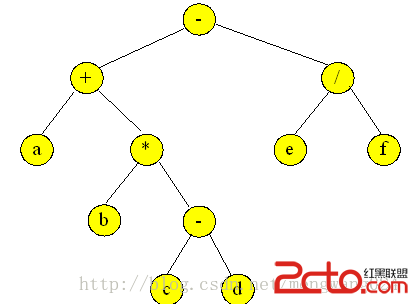#include#include #define INIT_STACK_SIZE 100 #define STACKINCREMENT 10 //*****二叉樹的二叉鏈表存儲結構*****// typedef struct BiNode { char data; struct BiNode *lchild, *rchild; int visitcount; //訪問次數(後序遍歷會用到) }BiNode, *BiTree; typedef struct { BiNode **base; BiNode **top; int stacksize; }SqStack; //*****初始化棧*****// void InitStack(SqStack &S) { if (!(S.base = (BiNode **)malloc(sizeof(BiTree) * INIT_STACK_SIZE))) { return; } S.top = S.base; S.stacksize = INIT_STACK_SIZE; return; } //*****元素進棧*****// void Push(SqStack &S, BiNode *e) { if (S.top - S.base >= S.stacksize) { if (!(S.base = (BiNode **)realloc(S.base, sizeof(BiTree) * (STACKINCREMENT + S.stacksize)))) { return; } S.stacksize += STACKINCREMENT; } *S.top++ = e; return; } //*****元素出棧*****// void Pop(SqStack &S, BiNode **e) { if (S.base == S.top) { return; } *e = *--S.top; return; } //*****取棧頂元素*****// int GetTop(SqStack S, BiNode **e) { if (S.base == S.top) { return 0; } *e = *(S.top - 1); return 1; } //*****判斷棧是否為空*****// int StackEmpty(SqStack S) { if (S.top == S.base) return 1; else return 0; } //*****按先序次序輸入二叉樹中結點的值(一個字符),空格字符表示空樹構造二叉鏈表表示的二叉樹T*****// void CreateBiTree(BiTree &T) { char ch; scanf("%c", &ch); if(ch == ' ') { T = NULL; } else { if(!(T = (BiNode *)malloc(sizeof(BiNode)))) { return; } T->data = ch; //生成根結點 CreateBiTree(T->lchild); //構造左子樹 CreateBiTree(T->rchild); //構造右子樹 } return; } //*****先序遍歷二叉樹方法1*****// void PreorderTraverse_1(BiTree T) { BiTree p; SqStack S; InitStack(S); Push(S, T); //根指針進棧 while(!StackEmpty(S)) { while(GetTop(S, &p) && p) { printf("%c ", p->data); Push(S, p->lchild); } Pop(S, &p); //空指針退棧 if(!StackEmpty(S)) { Pop(S, &p); //根結點出棧 Push(S,p->rchild); //右孩子進棧 } } return; } //*****先序遍歷二叉樹方法2*****// void PreorderTraverse_2(BiTree T) { BiTree p = T; SqStack S; InitStack(S); while (p || !StackEmpty(S)) { if (p) { printf("%c ", p->data); Push(S,p); p = p->lchild; } else { Pop(S, &p); p = p->rchild; } } } //*****中序遍歷二叉樹方法1*****// void InOrderTraverse_1(BiTree T) { SqStack S; BiTree p; InitStack(S); Push(S,T); while (!StackEmpty(S)) { while (GetTop(S,&p) && p) { Push(S,p->lchild); //向左走到盡頭 } Pop(S,&p); //空指針退棧 if (!StackEmpty(S)) { Pop(S,&p); printf("%c ", p->data); Push(S,p->rchild); } } return; } //*****中序遍歷二叉樹方法2*****// void InOrderTraverse_2(BiTree T) { BiTree p = T; SqStack S; InitStack(S); while (p || !StackEmpty(S)) { if (p) { Push(S,p); p = p->lchild; } else { Pop(S, &p); printf("%c ", p->data); p = p->rchild; } } return; } //*****後序遍歷二叉樹*****// void PostOrderTraverse(BiTree T) { SqStack S; BiTree p = T; InitStack(S); while (p || !StackEmpty(S)) { if(p) { if (p->visitcount != 2) { p->visitcount = 1; Push(S, p); } p = p->lchild; } else { Pop(S, &p); if(p->visitcount == 2) { printf("%c ", p->data); } else { p->visitcount++; Push(S, p); } p = p->rchild; } } return; } int main(void) { BiTree T; printf("請按先序次序輸入二叉樹中結點的值(字符),空格字符表示空樹:\n"); CreateBiTree(T); printf("先序遍歷方法1結果為:"); PreorderTraverse_1(T); printf("\n\n"); printf("先序遍歷方法2結果為:"); PreorderTraverse_2(T); printf("\n\n"); printf("中序遍歷方法1結果為:"); InOrderTraverse_1(T); printf("\n\n"); printf("中序遍歷方法2結果為:"); InOrderTraverse_2(T); printf("\n\n"); printf("後序遍歷結果為:"); PostOrderTraverse(T); printf("\n\n"); return 0; }
以如下二叉樹為例,給出按先序次序輸入二叉樹中結點的值(字符),從而按照本文給出的算法構造二叉樹。

輸入字符的順序是:-+a空格空格*b空格空格-c空格空格d空格空格/e空格空格f空格空格,即可驗證本文給出的遍歷算法。